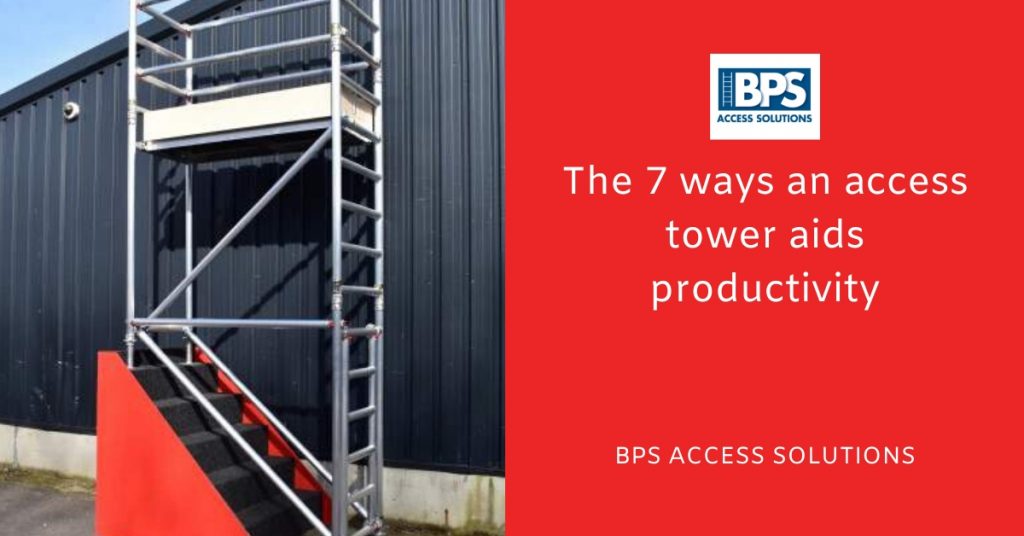The 7 ways an access tower aids productivity
Access towers, otherwise known as scaffold towers or tower scaffolds, are one of the most popular modern height access solutions. They take some of the key concepts which make ladders such a useful tool and build upon them to create something even better. There are a number of different ways that access towers aid productivity on the worksite, so we’ll run through a few of them below.
They are easy to erect
To begin with, scaffold towers are very easy to erect. They may look like a much more complex structure than a ladder, but in reality scaffold towers are built to be quick and simple to build. Each of the key structural components, including beams and connectors, fit together easily. There are a number of different types of connector made by the various producers of scaffold towers, but they are all designed with simplicity in mind. When it comes to aiding productivity, this can result in significant time savings when compared to erecting a full-size conventional scaffold, for example.
They can support much more weight than ladders
Ladders are good at providing height access, but they come with some fundamental drawbacks. Conventional two-footed ladders are unstable and step ladders cannot be built very high. Neither of these two types of ladder can support much weight, which can be a real issue when it comes to their use on a work site. Because they are much stronger, scaffold towers are often able to support the weight of one or more workers, as well as various tools. This is a clear benefit when it comes to productivity because it means tools and workers can be accessed much more easily.
They can be moved easily
Because they are reasonably small structures in comparison to full-scale scaffold systems, scaffold towers can be moved with relative ease. To move many scaffold towers, all that is required is a group of workers to lift the tower together and move it slowly to its new location. Even better, many scaffold towers come with lockable wheels on each leg. This means they can simply be wheeled to a new location and locked in place again when a worker needs access. This obviously amounts to significant productivity benefits as the scaffold tower doesn’t need to be deconstructed and then erected again in its new position.
They are adaptable
Because tower scaffold towers have a modular design, with individual components which fit together as required, they can be built to the height requirements of a specific job. For example, if access is required for a wall fitting 3.5 metres high in one part of a worksite, and then another fitting elsewhere which is 5.5 metres high, a scaffold tower can be erected in both locations using the same set of components. The modular design allows workers to construct a scaffold tower only as high as required. If a little extra height is required, it is easy to just add a few extra components to the one that is already in place.
They allow workers to work with both hands
The additional structural integrity of scaffold towers in comparison to ladders allows them to be used in significantly more heavy-duty applications. Not only can they support a lot more weight, they also offer significantly more protection for users. As opposed to ladders, which require users to maintain balance with their hands, scaffold towers have a working platform on top. This working platform is surrounded on all sides by guard rails, which can be used by workers to provide a stable surface to work against or hold on to. As far as productivity is concerned, this can save a lot of time.
They are safe
All the above points on the list effectively add up to show that access towers are a safe option for height access on the worksite. Rather than having to take additional safety precautions to use them, scaffold towers stand on their own four feet and do not have to be tied to other structures to remain stable. Again, this can save significant amounts of time during the construction and use phases.
They do not require extensive training to use
Although they may look daunting, access towers are very straightforward to use on the worksite. All workers have to do is climb the ladder, inside or out, and carry out their normal tasks on the working platform. There is no special training to use the working platform because it is just like working on the ground, except there are guard rails around the outside. Of course, anyone using a scaffold tower should be made aware of the risks of working at height. But in terms of special techniques for using the working platform go, it’s a very straightforward task.
For more information about the variety of different scaffold tower on the market, please contact us today.
No related posts.



